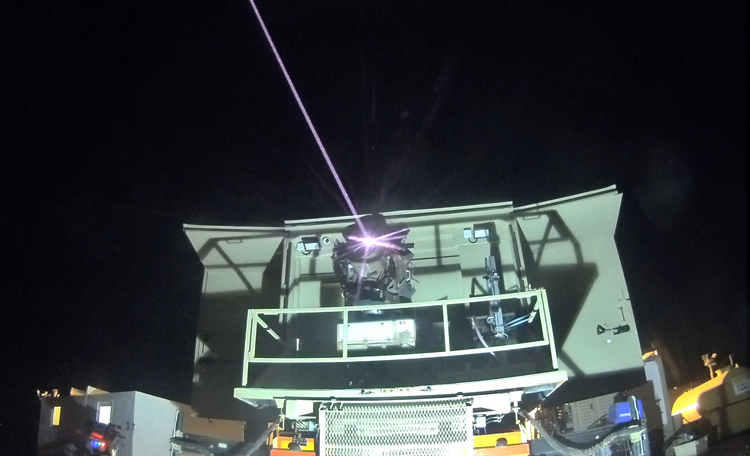INDIAN ARMED FORCES CHIEFS ON OUR RELENTLESS AND FOCUSED PUBLISHING EFFORTS

The insightful articles, inspiring narrations and analytical perspectives presented by the Editorial Team, establish an alluring connect with the reader. My compliments and best wishes to SP Guide Publications.

"Over the past 60 years, the growth of SP Guide Publications has mirrored the rising stature of Indian Navy. Its well-researched and informative magazines on Defence and Aerospace sector have served to shape an educated opinion of our military personnel, policy makers and the public alike. I wish SP's Publication team continued success, fair winds and following seas in all future endeavour!"

Since, its inception in 1964, SP Guide Publications has consistently demonstrated commitment to high-quality journalism in the aerospace and defence sectors, earning a well-deserved reputation as Asia's largest media house in this domain. I wish SP Guide Publications continued success in its pursuit of excellence.
- Appointments Committee of Cabinet approves one-month extension in service of Chief of the Army Staff
- Prime Minister witnesses 'Bharat Shakti' – a Tri-Services Firing and Manoeuvre Exercise in Pokhran, Rajasthan
- Interim Defence Budget 2024-25 — An Analysis
- Union Defence budget 2024
- Indian Army: In quest of greater firepower and policy recommendations for gaps
- Indian Army Annual Press Conference 2024
- Tata Boeing Aerospace Delivers 250 AH-64 Apache Fuselages, Manufactured in India
Next-Level DURGA DEW System
Directed Energy Weapon (DEW) Systems like Durga will significantly augment India's defence capabilities, especially against belligerent neighbours like China and Pakistan
 |
The Author is Former Director General of Information Systems and A Special Forces Veteran, Indian Army |

In April 2024, the Defence Research and Development Organisation (DRDO) had sought $100 million from the Ministry of Defence (MoD) to develop a high-power laser weapon, named Directionally Unrestricted Ray-Gun Array (DURGA) II, a lightweight directed energy weapon (DEW). This was to be a 100-kilowatt lightweight DEW that can be used by the Indian Armed Forces; providing cutting-edge technology capable of neutralising various threats, including drones, missiles, and artillery shells. The global DEW market was worth $4.1 billion in 2020 and is forecasted to reach $15.5 billion by 2027, with a CAGR of 19.63 per cent.
DEW is a type of weapon system that emits highly focused energy, typically in the form of lasers, microwaves, or particle beams, to incapacitate or destroy targets. Unlike traditional firearms or explosives which rely on kinetic energy (physical impact), DEWs use directed energy to achieve their effects. DEWs can be: Laser Weapons – using concentrated beam of coherent light to heat and damage the target; Microwave Weapons - emitting electromagnetic radiation in the microwave frequency range to disrupt/damage electronic systems; Particle Beam Weapons – accelerating charged/neutral particles to high velocities and direct them towards the target to cause damage through kinetic energy transfer or ionisation effects.
DRDO successfully tested the DURGA Mk-II (A); a 30-kilowatt DEW capable of neutralising drones, helicopters, and other aerial threats with precision.
Russia, France, Germany, the UK, Israel and China are reportedly among the countries that have programmed to develop DEWs or Laser Directed Energy Weapons. Earlier, the US had also accused Cuba of carrying out sonic attacks (Havana Syndrome). For India, application of this technology in the defence industry can transform the way wars will be fought, enabling India to produce cutting-edge platforms, weapons, sensors, and networks essential to fight and win a future war. DEWs could act as a deterrent against hostile nations such as China and Pakistan by increasing India's defence capabilities.

On April 13, 2025, the DRDO successfully tested the DURGA Mk-II (A); a 30-kilowatt DEW capable of neutralising drones, helicopters, and other aerial threats with precision. The system uses an intense laser beam to cause structural failure in targets and has electronic warfare capabilities, offering a cost-effective alternative to traditional weapons.
The system uses an intense laser beam to cause structural failure in targets and has electronic warfare capabilities, offering a cost-effective alternative to traditional weapons.
Key features and capabilities of the DURGA Mk-II (A) include: Power – the system is a 30-kilowatt laser-based weapon; Targeting – it uses a combination of radar and Electro-Optic (EO) systems to detect targets; Neutralisation – the high-power laser beam cuts through targets, causing them to burst into flames or experience structural failures; Threats – DURGA Mk-II (A) can neutralise various aerial threats, including single drones, drone swarms, fixed-wing aircraft, and incoming missiles; Electronic Warfare – the system also features electronic warfare (EW) capabilities to jam communication and satellite signals; Development – the DURGA system was developed by the DRDO's Centre for High Energy Systems and Sciences (CHESS), Hyderabad, in collaboration with academic institutions and Indian industries.
The significance and impact of DURGA Mk-II (A) is considerable. As a DEW, it offers a more cost-effective solution for countering drones compared to expensive ammunition or missile defence systems. Moreover, the system's precision minimises collateral damage, providing a more targeted and responsible approach to threat neutralisation. With the successful testing of DURGA Mk-II (A), India joins an elite group of nations, including the US, Russia, and China, with advanced laser weapon technology.
With the successful testing of DURGA Mk-II (A), India joins an elite group of nations, including the US, Russia, and China, with advanced laser weapon technology.
The US leads in the development of DEWs globally with a market share of 41.6 per cent, followed by China and Russia. The US Navy has integrated its LAWS system as a 30 KW solid-state laser onto the USS 'Pounce'. The laser device can incapacitate UAVs while removing boat propulsion systems along with the capability to detonate IEDs remotely. The HELIOS delivers 300 kilowatts of power to intercept drones, and fast-attack boats as well as missiles. The US Air Force operates with 'THOR' as a microwave-based drone-disabling platform.

The 'Bullet Curtain' is China's cutting-edge anti-drone system' The 'plane-to-point' interception approach of this defence system creates a projectile barrier against flying drones at low altitudes. China is also developing a high-powered microwave weapon which can disable satellites. Russia operates the 'Peresvet' laser weapon system, which can serve as an anti-satellite weapon besides C-UAS. The autonomous system targets satellites from 200 to 1,100 km altitude through 360 degrees of azimuth coverage. The Russian military has also enhanced its 'Pantsir' air defence system with laser technology. Recently, Russia showcased a laser rifle designed to counter small drones, specifically first-person view (FPV) models. The 'Iron Beam' system of Israel is DEW-based on a laser beam.
India's ambitious Mission Sudarshan Chakra project aims to link 6,000-7,000 radars, surveillance satellites, and directed energy weapons (DEWs) into a comprehensive national air defence network
The integration of artificial intelligence (AI) and machine learning (ML) into DEW systems will enhance their performance, making them more attractive to defence organisations. DEW-like lasers are also evolving with greater power and longer-range capability against a variety of aerial targets, including in the ASAT role. Their application could also be to protect vital assets and infrastructure from unmanned aerial system (UAS) terror attacks. DRDO is accordingly developing more advanced autonomous laser weapons with a longer range and greater power to target a variety of aerial threats. These systems will be deployed on static and mobile platforms along the border and heartland assets for rapid response capabilities. However, several challenges remain to DEW development and capabilities that need to be navigated for their induction as a mature capability in the Indian operational context.
As mentioned above, the original aim of DRDO was to develop a 100-kilowatt lightweight DEW that can be used by the Indian Armed Forces; a high-power laser weapon, named Directionally Unrestricted Ray-Gun Array (DURGA) II, a lightweight directed energy weapon (DEW). The DRDO plans to develop even larger laser weapons for integration into warships and aircraft, further enhancing India's 'Star Wars-like' capabilities.





